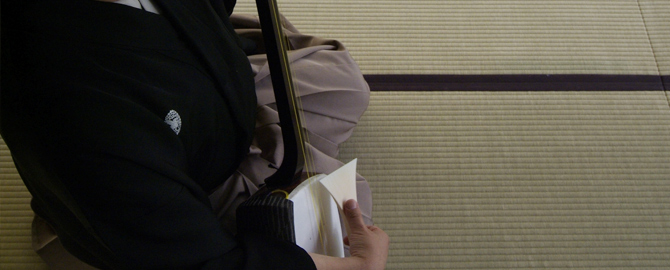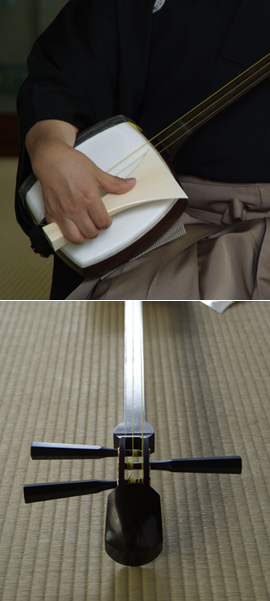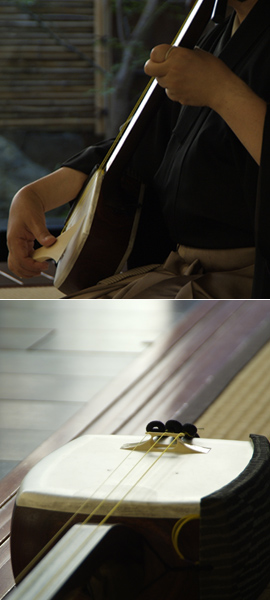About Shamisen

Origin
Most traditional Japanese instruments came from the Eurasian Continent. The shamisen is the newest among them and was introduced in the middle of the 16th century. It belongs to the lute family, a category of musical instruments, and is a global instrument with many relatives worldwide. There are even ancient Egyptian paintings from 5,000 years ago that depict women playing musical instruments similar to the shamisen.
The shamisen was initially introduced to Japan from overseas in the mid-16th century and became very popular in the mid-17th century. The popularity of this new instrument exploded during the Edo period.
Place of performance
While Kabuki, Japanese dance, and Bunraku (Japanese puppet theater) are prominent places for the shamisen to play an active role, the true value of Itchu-bushi can only be understood when it is enjoyed in a small group setting, such as in a sukiya-style (style of a tea-ceremony arbor) restaurant.
Itchu-bushi usually has one or two performers, although performing in a large group is more effective in an ample space.
Strangely enough, there are no shamisen-only performances in the Itchu-bushi. We always perform Jōruri and the songs with the shamisen. Itchu-bushi has a complex musical structure, meaning that the shamisen is not an accompaniment, but Jōruri, songs, and the shamisen perform independently. When I listened to the St. Matthew Passion, I realized that the musical structure of Itchu-bushi resembled the pre-Bach polyphonic sense.

String tuning
The shamisen has three strings. Its tuning consists of a combination of perfect 4ths and perfect 5ths, which are the mainstream in the world. It is characterized by the use of several types of methods, such as hon-choshi (the main tuning), niagari (raising the second string), and sansagari (lowering the third string).
Unlike the guitar, where the lowest string is always E, the shamisen does not have a constant pitch.
After taking into consideration such as the performer’s mood, the size of the playing area, whether the site is made of concrete or in a sukiya-style (style of a tea-ceremony arbor), humidity and vocal range of the singer( male’s vocal range is very different from female), the performer freely chooses the reference note, that is, the note of the lowest string, and starts tuning the string. This is because the string with the lowest note doubles as a resonance string called sawari, the relative pitch between each string does not change. These may be the distinguishing features of the shamisen.
I believe that tuning the shamisen is not just about matching the sounds of the instruments but about integrating one’s existence with the laws of nature.
The shamisen is an instrument with very unstable strings, so it is played while constantly being adjusted. Its unfixed instability suits the deep spirituality, subtle psychological descriptions, and scene descriptions of Itchu-bushi.
The same is true for human beings. Unless you feel that you are a part of nature and are sensibly integrated with nature’s providence, you will never get along with others and will not get a good resonance.
Instrument structure
The structure of the shamisen consists of a long sao, or neck made of hardwood called Koki or Red sanders, and a dō, or body made of quince, with cat or dog skin pasted on the body. The shamisen makes a sound by transmitting the vibration of silk strings to the skin by koma or bridge. There are more than a dozen variations in the thickness of the three threads, which are used according to the thickness of the neck and the tone desired by the performer. There are many types of Koma, or Bridge shapes, and materials such as ivory, reliquary (animal bones), buffalo horn, tortoiseshell, and mulberry. Bachi, or the plectrum, is mainly made from ivory, but it is also made of wood or plastic for practice.

Styles and Instruments
It is difficult to distinguish shamisen depending on the school of music played, but they have completely different characteristics. It can be roughly divided into three types: the futozao or fat neck used in Gidayū and Tsugaru, the chuzao or middle neck used in Itchu-bushi, Tokiwazu, Kiyomoto, and Kouta, and the hosozao or thin neck used in Nagauta. For example, it is absolutely impossible to play Itchu-bushi with Tsugaru shamisen.
The futozao shamisen is characterized by its loud and powerful tone. Chuzao is located in the middle between the futozao and the hosozao and is characterized by a wide range of expressive power, from delicate tones to dramatic expressiveness, from elegant and classy music to stylish and casual moods. The hosozao is characterized by its refreshing and clean tone.
Depending on the school, not only the instruments but also the playing methods may be completely opposite. For example, in nagauta, which uses the hosozao, it is absolutely forbidden to use a technique called neribachi, in which the bachi, or the plectrum, is in contact with the string for a long period of time. It is said that the time that Bachi is in contact with the thread is short and that the sound should be instantaneous.
For Itchu-bushi, using the tip of the Bachi, the thread is pulled softly, and the lingering sound produced by the thread slowly leaving the Bachi is highly valued.
Itchu-bushi shamisen
As I learned about Itchu-bushi, I came to believe that the itchu-bushi shamisen existed as an instrument that could express everything in the universe. Itchu-bushi is composed on the premise that it can accurately express all human emotions and natural phenomena, philosophical concepts, mathematical concepts, and everything that people can feel. It is believed that there is no limit to expression, and if there is something that cannot be expressed, it is the responsibility of the performer. The so-called “Te” melody pattern, which can express anything, is extremely finely organized. Players are required to combine these musical structures accurately and express everything with delicate and sophisticated performance techniques. That is why the itchu-bushi shamisen is extremely difficult and is said to be very attractive.

